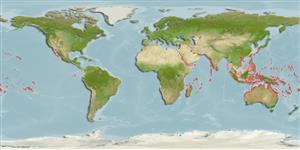Common names from other countries
>
Eupercaria/misc (Various families in series Eupercaria) >
Labridae (Wrasses) > Corinae
Etymology: Thalassoma: Greek, thalassa = the sea + Greek, soma = body; the colour of the sea (Ref. 45335).
More on author: Forsskål.
Environment: milieu / climate zone / depth range / distribution range
Ekologi
laut berasosiasi dengan karang; kisaran kedalaman 0 - 10 m (Ref. 30573). Tropical; 32°N - 32°S
Indo-Pacific: Red Sea and East Africa (Ref. 4392) to the Hawaiian, Marquesan, and Easter islands, north to southern Japan, south to Lord Howe, Kermadec, and Rapa islands. Southeast Atlantic: southeast coast of South Africa (Ref. 4392). Replaced by Thalassoma virens in the Revillagigedo Islands (Ref. 37816).
Size / Weight / umur
Maturity: Lm ? range ? - ? cm
Max length : 46.0 cm TL jantan/; (Ref. 30573); Berat maksimum terpublikasi: 1.2 kg (Ref. 40637)
Duri punggung (Keseluruhan (total)) : 8; duri punggung lunak (Keseluruhan (total)) : 12 - 14; Duri dubur: 3; Sirip dubur lunak: 10 - 12. T. purpureum and T. trilobatum have nearly identical initial phases (Ref. 1602). They differ slightly in details of the head markings, and T. purpureum has a slightly longer head, shorter pectoral fins, and attains a larger size (Ref. 1602, 48636). Females best distinguished by the 'V' mark on the snout (Ref. 48636). Initial phase with a vertical dark red line below front of eye usually with a branch to front of snout (Ref 9823).
Found almost exclusively in the surge zone of outer reef flats, reef margins, and rocky coastlines, down to a depth of about 10 m (Ref. 5213). Benthopelagic (Ref. 58302). Occur in groups of females that are spread out over large reef sections and dominated by few males. Males grow much larger than females (Ref. 48636). Feed on small invertebrates (crabs, sea urchins, brittlestars, mollusks), small fishes, echinoids, ophiuroids and polychaetes (Ref. 37816). Protogynous (Ref. 55080).
Life cycle and mating behavior
Maturities | Reproduksi, perkembang biakan | Spawnings | Egg(s) | Fecundities | Larva
Pelagic spawner.
Randall, J.E., G.R. Allen and R.C. Steene, 1990. Fishes of the Great Barrier Reef and Coral Sea. University of Hawaii Press, Honolulu, Hawaii. 506 p. (Ref. 2334)
Status IUCN Red List (Ref. 130435)
CITES (Ref. 128078)
Not Evaluated
ancaman kepada manusia
Harmless
penggunaan manusia
Perikanan: nilai komersial kecil; Ikan buruan: ya; Akuarium: Komersial
Alat, peralatan
laporan khas
muat turun XML
Sumber internet
Estimates based on models
Preferred temperature (Ref.
115969): 24.6 - 29.3, mean 28.3 (based on 3134 cells).
Phylogenetic diversity index (Ref.
82804): PD
50 = 0.5000 [Uniqueness, from 0.5 = low to 2.0 = high].
Bayesian length-weight: a=0.00955 (0.00430 - 0.02123), b=3.06 (2.89 - 3.23), in cm Total Length, based on LWR estimates for this Genus-body shape (Ref.
93245).
Trophic level (Ref.
69278): 3.8 ±0.0 se; based on diet studies.
Daya lenting (Ref.
120179): sedang, Waktu penggandaan populasi minimum 1.4 - 4.4 tahun (Preliminary K or Fecundity.).
Fishing Vulnerability (Ref.
59153): Moderate vulnerability (36 of 100).
